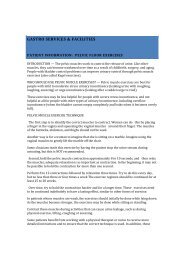Screening for colon cancer - Gastro Services and Facilities
Screening for colon cancer - Gastro Services and Facilities
Screening for colon cancer - Gastro Services and Facilities
You also want an ePaper? Increase the reach of your titles
YUMPU automatically turns print PDFs into web optimized ePapers that Google loves.
screening tests (like <strong>colon</strong>oscopy). The optimal screening plan depends upon the reason <strong>for</strong><br />
increased risk.<br />
Family history of colorectal <strong>cancer</strong><br />
- People who have one first-degree relative (parent, brother, sister, or child) with<br />
colorectal <strong>cancer</strong> or adenomatous polyps at a young age (be<strong>for</strong>e the age of 60 years), or two<br />
first-degree relatives diagnosed at any age, should begin screening <strong>for</strong> <strong>colon</strong> <strong>cancer</strong> earlier,<br />
typically at age 40, or 10 years younger than the earliest diagnosis in their family,<br />
whichever comes first. <strong>Screening</strong> usually includes <strong>colon</strong>oscopy, which should be repeated<br />
every five years.<br />
- People who have one first-degree relative (parent, brother, sister, or child) who has<br />
experienced colorectal <strong>cancer</strong> or adenomatous polyps at age 60 or later, or two or more<br />
second degree relatives (gr<strong>and</strong>parent, aunt, uncle) with colorectal <strong>cancer</strong> should begin<br />
screening at age 40, <strong>and</strong> screening should be repeated as <strong>for</strong> average risk people.<br />
- People with a second-degree relative (gr<strong>and</strong>parent, aunt, or uncle) or third-degree<br />
relative (great-gr<strong>and</strong>parent or cousin) with colorectal <strong>cancer</strong> are considered to have an<br />
average risk of colorectal <strong>cancer</strong> (See "Average risk of colorectal <strong>cancer</strong>" above).<br />
Familial adenomatous polyposis — People with a family history of familial adenomatous<br />
polyposis (FAP) should consider genetic counseling <strong>and</strong> genetic testing to determine if they<br />
carry the affected gene. People who carry the gene or do not know if they carry the gene<br />
should begin screening with sigmoidoscopy once every year, beginning at puberty.<br />
Colectomy (surgical removal of the <strong>colon</strong>) should be considered if multiple polyps are seen<br />
or genetic testing shows that the person carries the abnormal gene; colectomy is the only<br />
way to prevent colorectal <strong>cancer</strong> in people with FAP.<br />
Hereditary nonpolyposis <strong>colon</strong> <strong>cancer</strong> — People with a family history of hereditary<br />
nonpolyposis <strong>colon</strong> <strong>cancer</strong> (HNPCC) should consider genetic counseling <strong>and</strong> genetic testing<br />
to determine if they carry the affected gene. People who carry the gene or who do not know<br />
if they carry the gene should be screened with <strong>colon</strong>oscopy because HNPCC is associated<br />
with <strong>cancer</strong>s of the right-sided <strong>colon</strong> (which cannot be seen during sigmoidoscopy).<br />
Depending upon the family history <strong>and</strong> what is found, <strong>colon</strong>oscopy is usually repeated<br />
every one to two years between age 20 <strong>and</strong> 30 years, <strong>and</strong> every year after age 40. Because<br />
polyps can progress more rapidly to <strong>cancer</strong> in people with HNPCC, more frequent screening<br />
may be recommended.<br />
Inflammatory bowel disease — In people with ulcerative colitis or Crohn's disease of the<br />
<strong>colon</strong>, the optimal screening plan depends upon the amount of <strong>colon</strong> affected <strong>and</strong> the<br />
duration of the disease. <strong>Screening</strong> usually entails <strong>colon</strong>oscopy once every one to two years<br />
beginning after eight years of inflammation of the entire <strong>colon</strong> or after 15 years of colitis of<br />
the sigmoid <strong>colon</strong> <strong>and</strong> rectum. (See "Patient in<strong>for</strong>mation: Crohn's disease" <strong>and</strong> see "Patient<br />
in<strong>for</strong>mation: Ulcerative colitis").



